

Si l’école ressemblait davantage à Netflix - ApprendreEnseignerInnover.ca. How Today's Students Are Different And What It Means For You. What Teachers Want You To Know: A Note to School Administrators. Start Page. Edutopia. 5 Questions to Ask Yourself About Your Unmotivated Students. Les chefs d’école. — Bonjour, ça va bien ?

» Le 26 mai, à 9 h 10. Écouteurs aux oreilles, près des casiers avec deux copains, le jeune garçon salue la directrice de l’école secondaire des Sources, à Dollard-des-Ormeaux. Comme presque tous les jours, Geneviève Alain parcourt les corridors de son école dans les minutes qui précèdent l’entrée en classe. « Le nombre de problèmes que je règle juste en marchant, le matin ! », lance la directrice. La cloche a retenti. . « Les élèves ! What Innovation Is and Isn’t. To simplify the notion of innovation, it is something that is both new (either invention or iteration) and better.
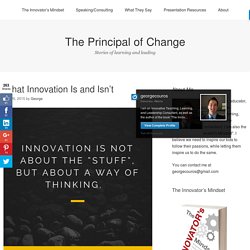
Innovation is not about the “stuff”, but about a way of thinking. For example, it is not the iPhone that is innovative, it was the thinking that created it in the first place. What is the future you would like to create? – The Principal of Change. Picture this… I have been appointed the new principal of your school.
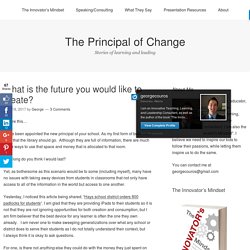
Recognize, Rectify, Move Forward – The Principal of Change. I try to always find a line of pushing participants in my sessions in their learning, without pushing them off a ledge.
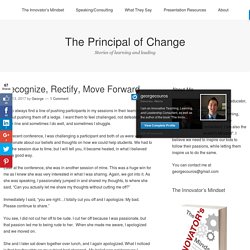
I want them to feel challenged, not defeated. It is a tough line and sometimes I do well, and sometimes I struggle. At a recent conference, I was challenging a participant and both of us were very passionate about our beliefs and thoughts on how we could help students. We had to end the session due to time, but I will tell you, it became heated, in what I believed was a good way. Later at the conference, she was in another session of mine. What Makes a Master Teacher – The Principal of Change. The term “master teacher” seems to get thrown around a lot, but is something that many educators aspire to be.
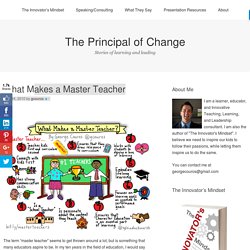
In my ten years in the field of education, I would say that the definition of “master teacher” has definitely changed. When I think of a master teacher, here are the qualities that I would suggest they have: 1. 8 Things to Look For in Today’s Classroom – The Principal of Change. As I think that leaders should be able to describe what they are looking for in schools I have thought of eight things that I really want to see in today’s classroom.

I really believe that classrooms need to be learner focused. This is not simply that students are creating but that they are also having opportunities to follow their interests and explore passions.1 The teacher should embody learning as well. Will Richardson recently wrote this in a comment on one of my recent posts on what teachers need to be like in our current day and the focus that needs to be on learning: …we need teachers who are masters at developing kids as learners who are adept at sense making around their own goals. Teachers who are focused on helping students develop the dispositions and literacies required to succeed regardless of subject or content or curriculumThis moment is all about learners having an amazing new freedom to learn, not teachers having an amazing new freedom to teach. 1.
10 Crucial Characteristics of Great Leaders – The Principal of Change. Leadership is not an easy endeavor.
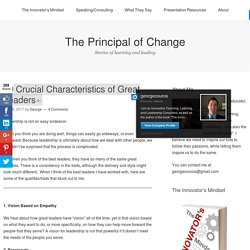
When you think you are doing well, things can easily go sideways, or even backward. Because leadership is ultimately about how we deal with other people, we shouldn’t be surprised that the process is complicated. Yet when you think of the best leaders, they have so many of the same great qualities. There is a consistency in the traits, although the delivery and style might look much different. 4 Student Engagement Tips (From a Student) I just graduated from Nashville Big Picture High School, and this is where I'm at in my life: I made a 20-minute documentary about my graduating class of 2016.I am getting paid to go to different places throughout Tennessee this summer to make videos explaining the products and services of various companies.I have a possible video job lined up when I enter college.I recently made a video for Edutopia.

Why Can't Teachers Make Decisions on Their Own? Today's guest blog is co-authored between Peter DeWitt and Jenni Donohoo.

Donohoo is a Provincial Literacy Lead in the Curriculum and Assessment Policy Branch in the Ontario Ministry of Education. The phrase 'shared decision making' might conjure up different ideas by teachers based on their past experiences. Sometimes the image is one of excitement because the last opportunity to share in decision making was empowering, provided growth in thinking, and resulted in actionable steps that changed the learning environment for students and teachers. And then sometimes...maybe most times...the image is not so exciting. Perhaps because teachers' voices didn't really count.
When formal leaders provide opportunities for shared leadership by affording others the power to make decisions, everyone benefits. It helps to build collective efficacy. It is to everyone's benefit to ensure decision making processes are transparent and involve teachers in authentic, meaningful ways.
The Tyranny of Being On Task. I remember when I was first teaching and was getting ready for my first official observation and evaluation.

I was very nervous. My principal had told me she would be looking for a classroom where students were on task. Heaven forbid that any students were off task. LaRésurrection et Saint Thomas-d'Aquin. Notre enquête. Besoins particuliers : 10 films d’animation pour comprendre la différence. Publié le 01-02-2017 à 16:19 Depuis que j’ai commencé à écrire, je me fais un devoir de faire de la sensibilisation, de briser des tabous et surtout d’outiller (ou encore motiver) les adultes qui entourent les enfants à besoins particuliers. 8 Strategies Robert Marzano & John Hattie Agree On. Robert Marzano and John Hattie have both reviewed research into what teaching strategies make the biggest difference to students’ results. While they used different methods and terminology, they agreed on these 8 powerful strategies. Strategy 1: A Clear Focus for the Lesson.
Développement de l'enfant. La rétroaction. Dans la vague de travaux prônant un enseignement basé sur des données probantes, la rétroaction est ressortie comme l’une des stratégies d’enseignement les plus efficaces pour favoriser la réussite des élèves. Ce dossier thématique offre un survol du thème de la rétroaction utilisée dans un contexte de classe à partir des documents et ressources recensés dans la bibliothèque virtuelle du RIRE. Nous tenons à remercier la précieuse collaboration de Monsieur Alexandre Buysse, professeur agrégé au Département d’études sur l’enseignement et l’apprentissage de l’Université Laval. En éducation, la rétroaction peut être abordée sous différents angles. 1. About Smart Classroom Management. Here at Smart Classroom Management, we believe in two principles thought by many to be on contradictory ends of the classroom management spectrum.
On one side we believe in faithfully following a classroom management plan. This allows teachers to hold students accountable without yelling, scolding, lecturing, or using any other stressful or hurtful method. Transform Your Staff Meetings, Engage Your Faculty. Time for another staff meeting. Need an idea for something that engages teachers? Shakes things up a bit? Starts the year off right? Lessee. Team Problem Solving: Paving the Path to Success for Every Student.
The faculty at University Park Campus School (UPCS) meets weekly to address problems from student conflicts to social media safety, solving problems before they get out of hand, actively meeting their students' needs, and creating an environment where students feel supported to tackle any challenge -- no matter how big.
"We have a diverse urban population, and the range of issues we have is pretty broad, whether in or outside the classroom," says Dan St. Louis, University Park's principal. Back-to-School Behavior Checklists. Administrator Checklist ❏ Welcome your staff in a positive way. ❏ Review the ten critical markers of PBIS implementation (See The PBIS Tier One Handbook) as a guide. ❏ Identify and communicate your behavior SMART goals with your staff. ❏ Provide time for the PBIS team to meet and help present information. ❏ Calendar monthly PBIS team meetings for the year.
Les principes d'un enseignement efficace. ‘Lesson Study’ Technique: What Teachers Can Learn From One Another. It Takes Courage to Make Schools Better. How One Teacher Changed for the Good of Her Students. Facebook. 8 stratégies d’enseignement efficaces selon Hattie et Marzano. Collaborative Planning: Integrating Curriculum Across Subjects.
The Critical Thinking Consortium - The Thinking Teacher. At the Movies: Films Focused on Education Reform. Beyond Measure (2015)Beyond Measure follows three different sets of teachers and students as they grapple with the realities of public education and try to enact meaningful change in their own education communities.